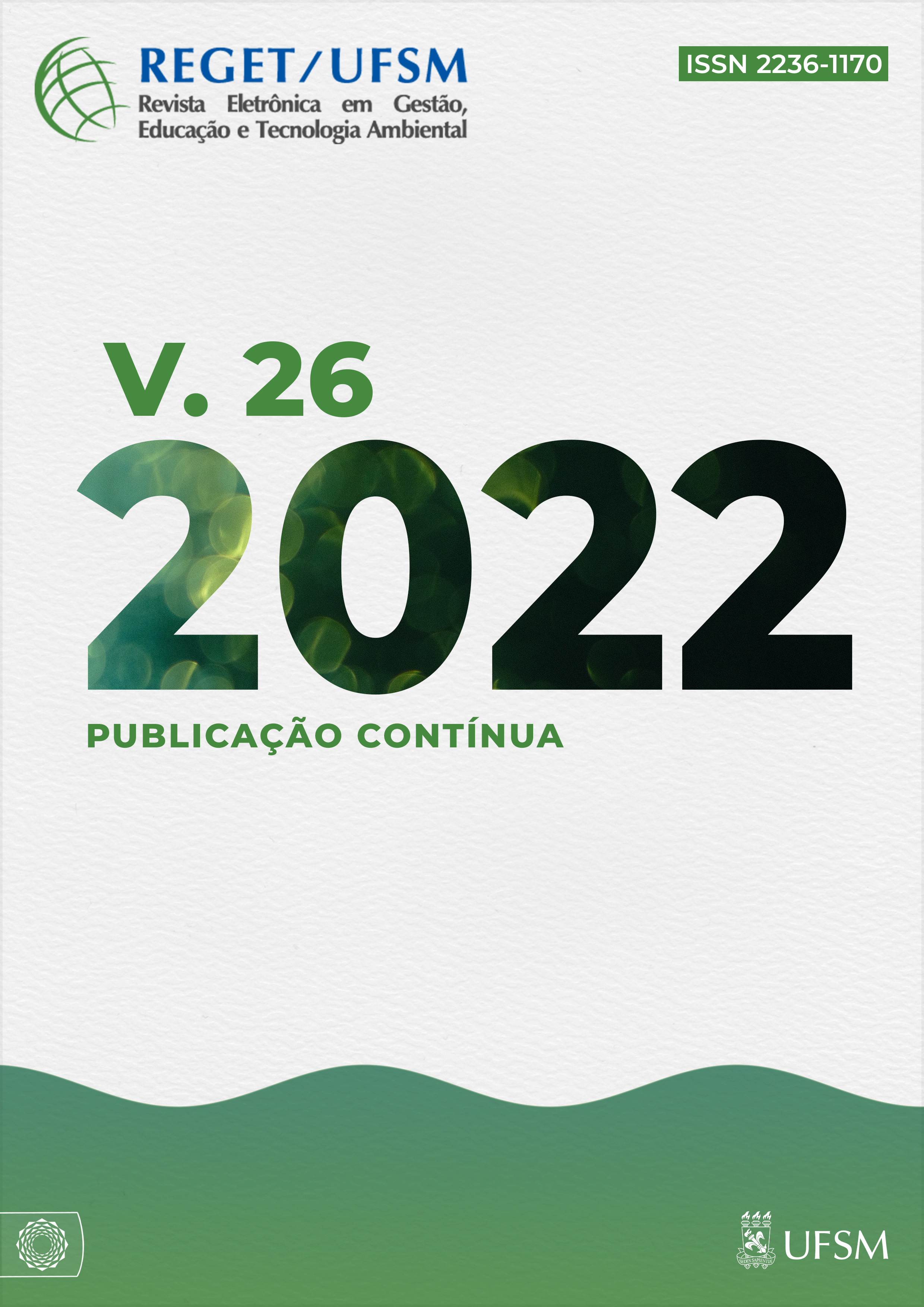Reuse of Magnesol® for Purification of Biodiesel
DOI:
https://doi.org/10.5902/2236117065590Keywords:
Magnesol®, Biodiesel, Purification, ReuseAbstract
Purification of biodiesel with dry adsorbents is an alternative method, as it uses compounds that eliminate the need for water in the process without generating liquid effluent. Currently, there is little discussion about the reuse of different types of adsorbents and in this context, the present work presents an efficient method of purification and investigates the performance of the reuse of Magnesol® in the purification of biodiesel in order to generate less waste to the environment. Therefore, the Magnesol® used was washed with several solvents with different polarity characteristics. Among the solvents tested, THF is the best solvent for the purification of Magnesol® and, after optimizing the Magnesol® purification process, it was concluded the best conditions are three washes in solvent / adsorbent ratio 30:1 at room temperature, resulting in only 3.89% of the residual value of contaminants and being an alternative for biodiesel companies.
Downloads
References
ALVES, M. J; CAVALCANTI, I. V; RESENDE, M. M; CARDOSO, V. L; REIS, M. H. Biodiesel dry purification with sugarcane bagasse. Industrial Crops and Products, v. 89, p. 119–127, 2016. https://doi.org/10.1016/j.indcrop.2016.05.005 DOI: https://doi.org/10.1016/j.indcrop.2016.05.005
American Society for Testing and Materials. Standard Test Methods for Instrumental Determination of Carbon, Hydrogen, and Nitrogen in Petroleum Products and Lubricants, ASTM D5291-16. United States of America, 2016.
American Society for Testing and Materials. Flash Point by Pensky-Martens Closed Tester, ASTM D 93. United States of America, 2001
ARAUJO, V. K. W. S; HAMACHER, S.; SCAVARDA, L. F. Economic assessment of biodiesel production from waste frying oils. Bioresource Technology, v. 101, p. 4415–4422, 2010. https://doi.org/10.1016/j.biortech.2010.01.101 DOI: https://doi.org/10.1016/j.biortech.2010.01.101
AYDIN, G. The Modeling and Projection of Primary Energy Consumption by the Sources. Energy Sources, Part B: Economics Planning and Policy, v. 10, p. 67–74, 2014. https://doi.org/10.1016/j.biortech.2010.01.101 DOI: https://doi.org/10.1080/15567249.2013.771716
European Committee for Standardization. Fat and oil derivatives - Fatty Acid Methyl Esthers (FAME) - Determination of ester and linolenic acid methyl ester contents, EN 14103. Czech Republic, 2003.
FACCINI, C. S.; CUNHA, M. E.; MORAES, M. S. A.; KRAUSE, L. C.; MANIQUE, M. C.; RODRIGUES, M. C. A.; BENVENUTTI, E. V.; CARAMÃO, E. B. Dry washing in biodiesel purification: A comparative study of adsorbents. Journal of the Brazilian Chemical Society, v. 22, p. 558–563, 2011. https://doi.org/10.1590/S0103-50532011000300021 DOI: https://doi.org/10.1590/S0103-50532011000300021
FARAG, R.; EL-ANANY, A. Improving the quality of fried oils by using different filter aids. Journal of the Science of Food and Agriculture, v. 86, p. 2228–2240, 2006. https://doi.org/10.1002/jsfa.2607 DOI: https://doi.org/10.1002/jsfa.2607
FERRARI, R. A.; OLIVEIRA, V. S.; SCABIO, A. Biodiesel from soybean: characterization and consumption in an energy generator. Quimica Nova, v. 28, p.19–23, 2005. http://dx.doi.org/10.1590/S0100-40422005000100004 DOI: https://doi.org/10.1590/S0100-40422005000100004
GOMIDE, R. Operações unitárias: operações de transferência de massa (1ª ed.) São Paulo, SP: Dag Gráfica, 1988.
KUCEK, K. T.; CÉSAR‐OLIVEIRA, M. A. F.; WILHELM, H. M.; RAMOS, L. P. Ethanolysis of refined soybean oil assisted by sodium and potassium hydroxides. Journal of the American Oil Chemists' Society, v. 84, p. 385–392, 2007. https://doi.org/10.1007/s11746-007-1048-2 DOI: https://doi.org/10.1007/s11746-007-1048-2
LÔBO, I. P.; FERREIRA, S. L. C.; CRUZ, R. S. Biodiesel: quality parameters and analytical methods. Quimica Nova, v. 32, p. 1596–1608, 2009. http://doi.org/10.1590/S0100-40422009000600044 DOI: https://doi.org/10.1590/S0100-40422009000600044
LOPES, W. A.; FASCIO, M. Flow chart for infrared spectra interpretation of organic compounds. Quimica Nova, v. 27, p. 670-673, 2004. http://dx.doi.org/10.1590/S0100-40422004000400025 DOI: https://doi.org/10.1590/S0100-40422004000400025
PANAGIOTOPOULOU, P. M.; TSIMIDOU, M. Solid Phase Extraction: Applications to the Chromatographic Analysis of Vegetable Oils and Fats. Grasas y Aceites, v. 53, p. 84-95, 2002. https://doi.org/10.3989/gya.2002.v53.i1.292 DOI: https://doi.org/10.3989/gya.2002.v53.i1.292
RAMOS, A.; RODRIGUES, L. F.; DE ARAUJO, G. E.; POZOCCO, C. T.; KETZER, J. M.; HEEMANN, R.; LOUREGA, R. V. Geochemical characterization of Irati and Palermo formations (Paraná Basin–Southern Brazil) for shale oil/gas exploration. Energy Technology, v. 3, p. 481-487, 2015. https://doi.org/10.1002/ente.201402107 DOI: https://doi.org/10.1002/ente.201402107
SILVERSTEIN, R. M.; BASSLER, G. C. Spectrometric identification of organic compounds. Journal of Chemical Education, v. 39, p. 546, 1962. DOI: https://doi.org/10.1021/ed039p546
SUNDUS, F.; FAZAL, M. A.; MASJUKI, H. H. Tribology with biodiesel: A study on enhancing biodiesel stability and its fuel properties. Renewable & Sustainable Energy Reviews, v. 70, p. 399–412, 2017. https://doi.org/10.1016/j.rser.2016.11.217 DOI: https://doi.org/10.1016/j.rser.2016.11.217
TURAN, S.; YALCUK, A. Regeneration of used frying oil. Journal of the American Oil Chemists' Society, v. 90, p. 1761–1771, 2013. https://doi.org/10.1007/s11746-013-2325-x DOI: https://doi.org/10.1007/s11746-013-2325-x
WRETENSJÖ, I.; KARLBERG, B. Characterization of Sterols in Refined Borage Oil by GC – MS. Journal of the American Oil Chemists' Society, v. 79, p. 1069–1074, 2002. https://doi.org/10.1007/s11746-002-0605-4 DOI: https://doi.org/10.1007/s11746-002-0605-4
Downloads
Published
How to Cite
Issue
Section
License
Copyright (c) 2022 Revista Eletrônica em Gestão, Educação e Tecnologia Ambiental

This work is licensed under a Creative Commons Attribution-NonCommercial-ShareAlike 4.0 International License.
DECLARATION




